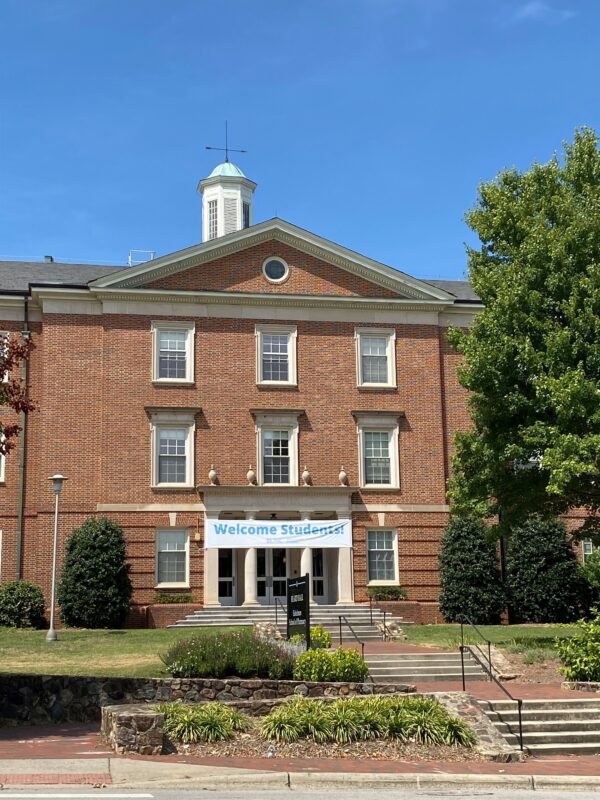Kicking off college road trips: Tar Heels vs. Blue Devils
It’s college road trip season. At the end of August in 100-degree heat, visiting Charlotte, North Carolina, captured the back-to-school buzz. The University of North Carolina-Chapel Hill Tar Heels and the Duke University Blue Devils are historic rivals and NCAA powerhouses that are separated by just a 20-minute drive.
Driving from Burlington to Charlotte is around 14 hours, or a two-hour direct flight. It is important for high school students to visit college campuses to feel the campus pulse and community. Both universities have highly selective admissions criteria. Their well-rounded reputations include exceptional learning opportunities and athletic programs.
Tobacco Road is a 12-mile stretch that connects the University of North Carolina-Chapel Hill and Duke University. The competition between the two colleges includes the basketball court. In their first matchup in 1920, the Tar Heels dominated the Blue Devils 36-25. Since the colleges are close, the outpouring of fans is an excuse to keep the competition alive.
The University of North Carolina-Chapel Hill is a state university with nearly 19,000 undergraduates. It is 730 acres and divided into north, middle and south campuses. It was established in 1789 as the first public university in America. Since 1982, North Carolina law requires that 82 percent of the students be from in-state.
Driving through the gates takes nearly five minutes to Keenan Stadium which was built in 1888 and holds 50,000 football fans. Carolina Blue is everywhere: Tar Heels banners and logos on T-shirts are printed in a specific Pantone blue color to represent the brand.

The University of North Carolina welcomes students with a banner at the pharmacy school.
The Tar Heels compete in the ACC Division 1 Conference. The NCAA basketball team has been Conference Champions 39 times in the regular season and qualified 26 times for tournaments. Competing in the NCAA Tournaments for 52 years, they won six Championships and played in 21 Final Four games.
Many buildings are named after prominent figures. Hill Hall Music Center was originally known as the Carnegie Library, endowed by Andrew Carnegie. It was expanded by the philanthropic support of John Sprunt Hill.
The campus history is deeply rooted in the South. The Virtual Museum of North Carolina Archeology explains that the university remained open during the Civil War. By the end of the war, only around a dozen students were enrolled. Also, Cameron Avenue, running through campus, was a dirt road until it was paved in 1927. The trivia of living history is peppered throughout campus.
Duke University is just a 20-minute drive north. Duke is a private school with nearly 7,000 undergraduates. The last week of August was move-in day with cars from New Jersey, New York and North Carolina. Students and parents wore swag from sweatshirts to caps. They looked like a pep rally of proud Blue Devils.
Duke competes in the ACC Division 1 Conference. The team holds the fourth most all-time wins of any NCAA men’s basketball team. Duke won five NCAA Championships, competed in 11 Championship games (third all-time) and played in 17 Final Four games.
The stately grey buildings are made of Duke stone. Since the 1920s, the distinct stone is blasted from a quarry located at Duke Forest. More than 100 buildings are built with the stone in deep blues, rich brown, dusty greys and fiery ochres, as explained in Duke Today.
Entering through the gate, undergraduate housing and buildings are concentrated on the west campus around Duke Chapel. This makes a big place feel much smaller. The graduate schools for business and engineering are on the outskirts of the gate.
Duke has 8,600 acres on three contiguous sub-campuses in Durham and a marine lab in Beaufort, N.C. Everything is big: six library branches, many athletic fields and complexes, and 34 on-campus dining locations.
More than 60 percent of Duke’s campus is covered in green. Southern moss, magnolias, willow oaks and loblolly pines make the university feel like a quiet community. It is tucked away from Durham, the fourth largest city in North Carolina.
Visiting colleges that are near one another can provide a nuanced comparison of the history each holds. Be sure to register for the Admissions Information Session and Tour. Stop by the athletic facilities to visualize the college experience.
Bring a notebook to capture your impressions in developing your college list and reflecting on your essays. Before you know it, in around five months, March Madness might feature the Tar Heels and Blue Devils rivalry.
(Margo Bartsch founded College Essay Coach, a full-service college admission business, and has been an adjunct professor in business at Champlain College and at Middlebury College.)
